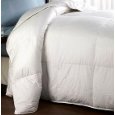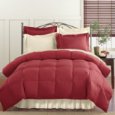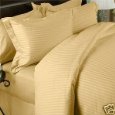King Size Down Comforter
The best info and the best deals on King size down comforters.
|
King Size Down Comforter Kingsize Down ComforterSo, you're looking for a King Size Down Comforter. Well, this site should help you out with your search. Here you will find some useful information regarding most types of down comforters. Sizes, materials, fillings and shell types of are discussed below. Also listed are the various manufacturers and outlets where you might find the comforter you are looking for. We hope this information is helpful.
A standard comforter is a type of blanket. Comforters are generally intended to keep the user warm, especially during sleep, although they can also be used as mattress pads. Comforters are generally large and rectangular in shape, filled with natural or synthetic insulating material and encased in a shell/covering. Comforters are commonly used with a set of sheets and or additional blankets. Comforter sizes will correspond with bed sizes like twin, full, queen, king, and cal-king. Comforter sizes will
run larger than actual bed sizes to allow for full coverage over the sides of the bed. The typical sizes in the
United States for comforters are: Twin at about 64" in Width x 87" in Length. Queen or Full at around 87" in Width
x 87" in Length. And King which is about 101" in Width x 90" in Length. Comforter construction: Comforter Materials and Terms: Acrylic – Man-made fiber that feels like soft wool. Acrylic products are machine washable, hypoallergenic, durable and moth-resistant. Baffles – A construction feature found in better down comforters. Baffles are small fabric walls sewn in between the top and bottom of the comforter shell. Down enclosed in the baffles is prevented from shifting and allowed to fully loft (fluff up). Cotton – All natural, pure cotton is the softest and most breathable fabric. The length of its fiber, the "staple, measures the quality of cotton. Types of cotton include: Combed cotton – Cotton fibers which have undergone an additional manufacturing process called "combing." It
reduces the quantity of uneven, short fibers, leaving the longer, stronger fibers for weaving Down alternative – Synthetic or natural filling material used in comforters and duvets, with insulating and warming properties similar to down. Primaloft® is a top quality, hypoallergenic synthetic fill; wool and silk are popular natural fills. Feathers – In bedding, plumage from a goose or duck. Though also lightweight, feathers are heavier than down, with quills that give them a resilient spring. Fill - Material used to stuff comforters, feather beds and other similar cased bedding items. Goose down, silk and Primaloft® are types of fill. Fill Power – In down bedding, the measurement in cubic inches than a single ounce of down will fill. Quality down comforters have a fill power between 550 and 650 cubic inches; the higher the fill power number, the warmer the comforter. Flannel - While it can be made from wool or a blend, cotton is the most common type of flannel. Brushing of the fabric results in a very soft, fuzzy feel. Flannel is popular for its warmth and comfort. Hand – Term for how a fabric feels to the touch; for example, cashmere has a smooth hand. Hypoallergenic – Indicates a product that is largely allergen-free or with little chance of causing allergenic reaction. Jacquard – In fabrics, an intricate, complex type of weaving and the cloth it produces. A loom outfitted with a "jacquard attachment" produces jacquards. Matelasse - Soft, double cloth or compound fabric with a quilted surface. Often, heavier constructions are made on a Jacquard loom and used for coverlets. Polyester – Man-made fiber often blended with cotton or other fibers Synthetic – Any man-made material used in manufacturing; examples: microsuede, polyester, acetate, etc. Thread-count – A measurement of fabric density reflecting the number of threads per square inch. A high thread count results in finer, smoother weave, and can extend the life and increase the value of your bedding. These are just a few examples of the materials and processes used to make quality Kingsize down conforters and comforters of twin and queen sizes as well. What it all boils down to is... What do you like?... and... How much do you want to spend?... As with most things, you usually get what you pay for.
|
|
Copywrite@ KINGSIZEDOWNCOMFORTER.COM All Rights Reserved



